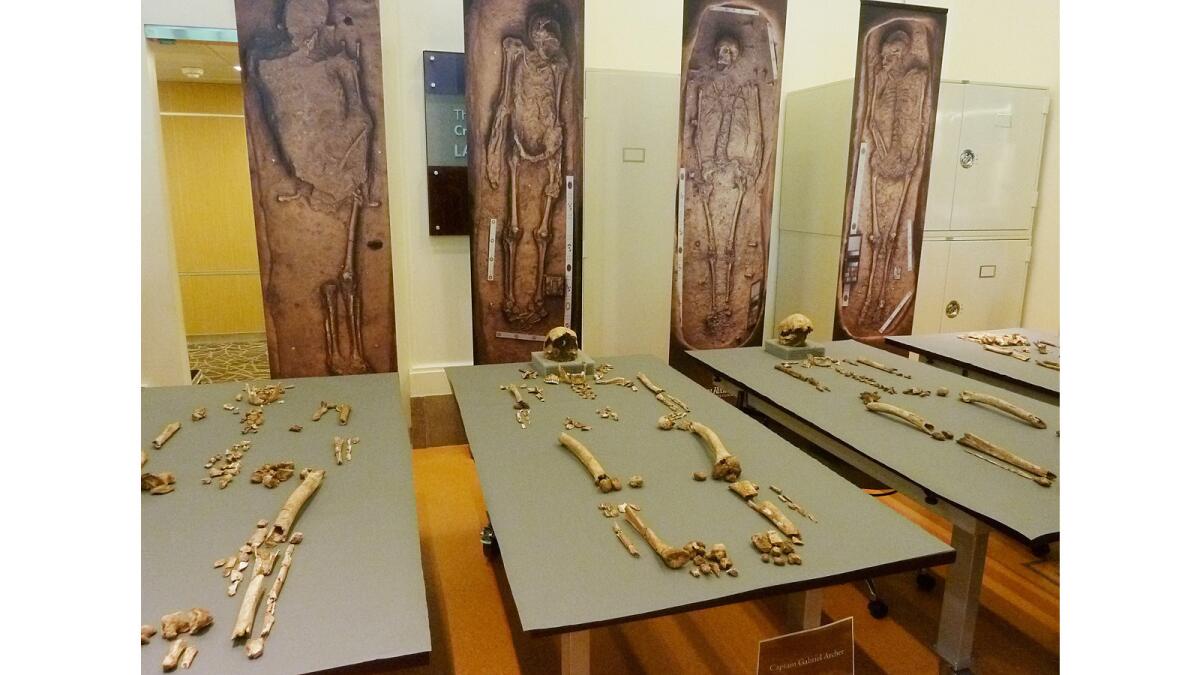Jamestown remains identified as those of Virginia colony’s early leaders

The bones of four of the early leaders of Virginias’s Jamestown settlement are displayed at the Smithsonian Institution in Washington.
Jamestown archaeologists working with the Smithsonian Institution have identified four sets of remains found inside the footprint of a 1608 church as prominent early leaders of the historic Virginia colony.
Buried between 1608 and 1610, the remains were excavated in late 2013 and publicly identified Tuesday at the Smithsonian Institution’s National Museum of Natural History after some 20 months of historical, genealogical and forensic investigation.
They include the Rev. Robert Hunt — who served as the first Anglican minister in English America — and Capt. Gabriel Archer — the explorer and council member who battled frequently with Capt. John Smith and others over the leadership of the colony.
Also identified were Sir Ferdinando Wainman, who was named by his cousin Gov. Thomas West, Lord De La Warr, as master of ordnance and a council member, and their kinsman Capt. William West, who was killed in a clash with Indians at the Fall of the James.
“We’ve known since 2010 that there were burials in the chancel of the church,” said Jamestown Rediscovery Director William M. Kelso earlier this month in an interview at the gravesite. “But now we know they held the remains of some of the colony’s founders.”
All four of the burials revealed remains that — because of their relatively exposed location inside the settlers’ fort — had deteriorated more than the graves at other sites protected by deeper layers of fill.
“They weren’t in the greatest shape. They were badly decayed,” Kelso said. “So it’s a good thing we didn’t wait any longer to dig.”
In addition to the skeletal remains, the archaeologists found stains and nails left by three wooden coffins, including two rare examples that were finely crafted into an anthropomorphic or human shape.
They also unearthed a fragment of a captain’s leading staff and a mass of silver-spangled fabric — both signs of military rank.
Among the most surprising finds was a metal box identified as a silver Catholic reliquary, containing half a dozen bone fragments and two lead ampuls like those used to hold holy water or the blood of a saint.
Such talismans were outlawed by English anti-Catholic laws in 1571 and could only have been held in secret among the colonists at Protestant Jamestown.
“We’ve found other Catholic artifacts,” Historic Jamestowne President James Horn says, describing a group of objects that includes forbidden crucifixes, pilgrim’s badges and rosary beads. “So there’s further research to be done. This is an enigma.”
Parallel investigations of the artifacts took place at the Jamestown Rediscovery lab, where conservator Michael Lavin and archaeologist David Givens overcame the initial challenges posed by the box and fabric — which couldn’t be opened without causing damage — by locating advanced digital X-ray scanning equipment powerful enough to peer inside them.
“We didn’t know if we’d be able to see through the silver,” Givens said, describing a series of visits that took them to three different labs, each with more powerful equipment. “But we did.”
The excavation and follow-up research confirmed the importance of the church and the governor’s June 1610 arrival at the colony, which was nearly destroyed by the deadly trials of the 1609-10 Starving Time. De La Warr stayed to clean up and rebuild the settlement in ways that helped ensure its long-term survival.
Burying his kinsman in the chancel gave the governor a chance to make a statement, Horn said, beginning with the elaborate coffins.
“There was a lot of talk about people of worth when his expedition arrived in 1610. It was a real stepping-up in the caliber of the colonists here compared to 1607,” Horn explained.
“And that tells us a lot about the changing approach to the colony and the enormous growth of the investment in that effort.”
More to Read
Sign up for Essential California
The most important California stories and recommendations in your inbox every morning.
You may occasionally receive promotional content from the Los Angeles Times.










